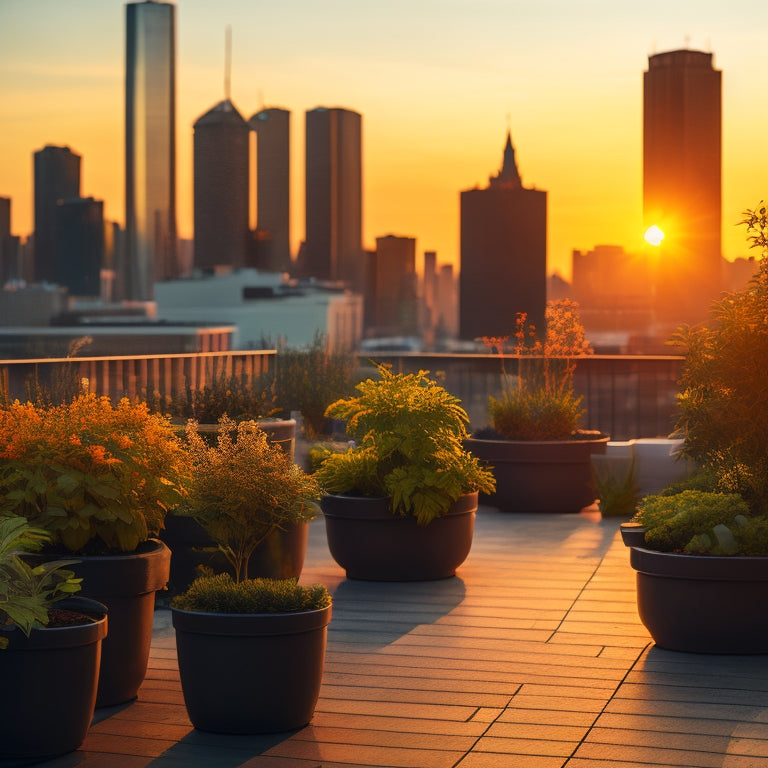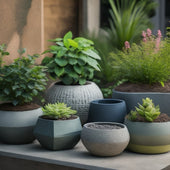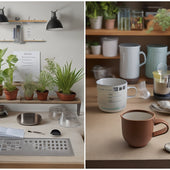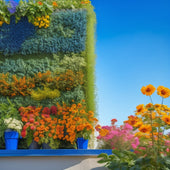
3 Best Weather-Resistant Planters for Rooftop Gardens
Share
To create a thriving rooftop garden, you'll need planters that can withstand extreme weather conditions. Look for aerodynamic designs with low centers of gravity, made from durable materials like fiberglass, concrete, or thick-gauge steel, which can resist winds up to 100 mph. Insulated materials like polypropylene, polyethylene, or fiberglass will help maintain stable temperatures and protect plant roots from freezing. Finally, opt for planters with built-in drainage solutions and moisture retention properties to handle heavy rainfall and snowmelt. With the right planter, you'll be well on your way to crafting a resilient rooftop oasis – and there's more to explore to guarantee your garden's success.
Key Takeaways
• Look for planters with aerodynamic designs, low center of gravity, and reinforced anchoring systems to withstand extreme wind conditions.
• Choose planters made from durable, insulated materials like polypropylene, polyethylene, or fiberglass to resist freezing temperatures.
• Select planters with built-in drainage solutions and moisture retention properties to handle heavy rainfall and snowmelt.
• Consider planters with wider bases and lower centers of gravity to prevent tipping and ensure stability in harsh weather.
• Opt for planters made from heavy-duty materials like thick-gauge steel, concrete, or heavy-duty ceramic to withstand harsh rooftop conditions.
Planters for Extreme Wind Conditions
When designing a rooftop garden in an area prone to extreme wind conditions, you'll need planters that can securely anchor plants and withstand gusts of up to 100 mph or more.
To achieve this, you'll want to focus on planters with aerodynamic designs that reduce wind resistance and minimize the risk of toppling. Look for planters with a low center of gravity, rounded edges, and a sleek profile that allows wind to flow smoothly around them.
Material durability is also essential in withstanding harsh winds. Opt for planters made from heavy-duty, weather-resistant materials like fiberglass, concrete, or thick-gauge steel. These materials can withstand the intense forces generated by extreme winds, ensuring your plants remain safe and secure.
Additionally, consider planters with reinforced anchoring systems, such as weighted bases or built-in anchor points, to provide extra stability.
Resistant to Freezing Temperatures
You'll need planters that can withstand freezing temperatures, as rooftop gardens in colder climates are exposed to ice, snow, and subzero temperatures that can cause materials to crack, shatter, or become brittle. Insulated materials are a must to maintain a stable temperature and protect the roots of your plants from freezing.
Look for planters made from materials like polypropylene, polyethylene, or fiberglass, which can withstand temperatures as low as -20°F (-29°C) or lower.
When selecting planters, consider the specific needs of your plants. If you're growing plants that are sensitive to frost, choose planters with built-in insulation or thermal mass to regulate soil temperature. For example, planters with a built-in water reservoir can help keep the soil from freezing by releasing heat as the water freezes.
Plant selection is also essential; choose plants that are tolerant of frost and freezing temperatures, such as succulents or alpine plants.
Withstanding Heavy Rainfall and Snow
Heavy rainfall and snowmelt can put tremendous pressure on rooftop planters, so it's crucial to select ones that can handle excess water and weight without compromising their structural integrity.
When shopping for planters, look for those with built-in drainage solutions, such as holes or channels that allow water to escape. This will prevent waterlogged soil and reduce the risk of planter damage. Additionally, consider planters with moisture retention properties, which will help regulate soil moisture levels and prevent washing away.
You'll want to choose planters made from materials that can withstand the weight of snow and water, such as durable plastics, metal, or heavy-duty ceramic. Avoid lightweight or fragile materials that may crack or shatter under pressure.
Also, consider the planter's design and shape, opting for ones with a wider base and lower center of gravity to prevent tipping or toppling.
Frequently Asked Questions
Can I Use Weather-Resistant Planters on a Balcony or Small Patio?
'As you're maximizing your balcony space, you're probably wondering if weather-resistant planters are a good fit. Coincidentally, they're perfect for small patios too! Look for planters made from durable materials like polypropylene or fiberglass to guarantee they can withstand the elements.'
Do Weather-Resistant Planters Require Special Maintenance or Care?
You'll find that weather-resistant planters require minimal maintenance, but you'll still need to inspect the material's durability seasonally and make adjustments accordingly, ensuring peak performance and longevity.
Can I Paint or Decorate Weather-Resistant Planters Myself?
You can easily give your weather-resistant planters a personalized touch by painting or decorating them yourself, exploring various DIY planter designs and selecting suitable paint types, like acrylic or epoxy, that withstand outdoor conditions.
Are Weather-Resistant Planters Safe for Vegetable or Herb Gardens?
When growing veggies or herbs, you'll want to guarantee your weather-resistant planters facilitate proper nutrient retention and address drainage concerns to prevent waterlogged soil, promoting healthy root development and maximizing your harvest.
Do Weather-Resistant Planters Come With a Warranty or Guarantee?
You'll be relieved to know that many high-quality planters come with a reassuring warranty, typically offering 1-5 years of warranty coverage, ensuring your investment in product longevity is protected, giving you peace of mind.
Related Posts
-

5 Best DIY Planter Ideas to Upcycle Concrete
You're about to breathe new life into discarded concrete blocks by transforming them into functional and visually app...
-

5 Best DIY Planter Ideas to Upcycle Concrete
You're about to breathe new life into discarded concrete blocks by transforming them into functional and visually app...
-

5 Best DIY Planter Ideas to Upcycle Concrete
You're about to breathe new life into discarded concrete blocks by transforming them into functional and visually app...
-

5 Best DIY Planter Ideas to Upcycle Concrete
You're about to breathe new life into discarded concrete blocks by transforming them into functional and visually app...
-

5 Best DIY Planter Ideas to Upcycle Concrete
You're about to breathe new life into discarded concrete blocks by transforming them into functional and visually app...
-

5 Best DIY Planter Ideas to Upcycle Concrete
You're about to breathe new life into discarded concrete blocks by transforming them into functional and visually app...
-

5 Best DIY Planter Ideas to Upcycle Concrete
You're about to breathe new life into discarded concrete blocks by transforming them into functional and visually app...
-

5 Best DIY Planter Ideas to Upcycle Concrete
You're about to breathe new life into discarded concrete blocks by transforming them into functional and visually app...
-

5 Best DIY Planter Ideas to Upcycle Concrete
You're about to breathe new life into discarded concrete blocks by transforming them into functional and visually app...
-

5 Best DIY Planter Ideas to Upcycle Concrete
You're about to breathe new life into discarded concrete blocks by transforming them into functional and visually app...
-

5 Best DIY Planter Ideas to Upcycle Concrete
You're about to breathe new life into discarded concrete blocks by transforming them into functional and visually app...
-

5 Best DIY Planter Ideas to Upcycle Concrete
You're about to breathe new life into discarded concrete blocks by transforming them into functional and visually app...
-

5 Best DIY Planter Ideas to Upcycle Concrete
You're about to breathe new life into discarded concrete blocks by transforming them into functional and visually app...
-

5 Best DIY Planter Ideas to Upcycle Concrete
You're about to breathe new life into discarded concrete blocks by transforming them into functional and visually app...
-

5 Best DIY Planter Ideas to Upcycle Concrete
You're about to breathe new life into discarded concrete blocks by transforming them into functional and visually app...
-

5 Best DIY Planter Ideas to Upcycle Concrete
You're about to breathe new life into discarded concrete blocks by transforming them into functional and visually app...
-

5 Best DIY Planter Ideas to Upcycle Concrete
You're about to breathe new life into discarded concrete blocks by transforming them into functional and visually app...
-

5 Best DIY Planter Ideas to Upcycle Concrete
You're about to breathe new life into discarded concrete blocks by transforming them into functional and visually app...
-

Accurate Measurements for Self-Watering Planters Made Easy
You're about to reveal the secrets of self-watering planters, and it all starts with precise measurements. Begin by a...
-

Accurate Measurements for Self-Watering Planters Made Easy
You're about to reveal the secrets of self-watering planters, and it all starts with precise measurements. Begin by a...
-

Accurate Measurements for Self-Watering Planters Made Easy
You're about to reveal the secrets of self-watering planters, and it all starts with precise measurements. Begin by a...
-

Accurate Measurements for Self-Watering Planters Made Easy
You're about to reveal the secrets of self-watering planters, and it all starts with precise measurements. Begin by a...
-

Accurate Measurements for Self-Watering Planters Made Easy
You're about to reveal the secrets of self-watering planters, and it all starts with precise measurements. Begin by a...
-

Accurate Measurements for Self-Watering Planters Made Easy
You're about to reveal the secrets of self-watering planters, and it all starts with precise measurements. Begin by a...
-

Accurate Measurements for Self-Watering Planters Made Easy
You're about to reveal the secrets of self-watering planters, and it all starts with precise measurements. Begin by a...
-

Accurate Measurements for Self-Watering Planters Made Easy
You're about to reveal the secrets of self-watering planters, and it all starts with precise measurements. Begin by a...
-

Accurate Measurements for Self-Watering Planters Made Easy
You're about to reveal the secrets of self-watering planters, and it all starts with precise measurements. Begin by a...
-

Accurate Measurements for Self-Watering Planters Made Easy
You're about to reveal the secrets of self-watering planters, and it all starts with precise measurements. Begin by a...
-

Accurate Measurements for Self-Watering Planters Made Easy
You're about to reveal the secrets of self-watering planters, and it all starts with precise measurements. Begin by a...
-

Accurate Measurements for Self-Watering Planters Made Easy
You're about to reveal the secrets of self-watering planters, and it all starts with precise measurements. Begin by a...
-

Accurate Measurements for Self-Watering Planters Made Easy
You're about to reveal the secrets of self-watering planters, and it all starts with precise measurements. Begin by a...
-

Accurate Measurements for Self-Watering Planters Made Easy
You're about to reveal the secrets of self-watering planters, and it all starts with precise measurements. Begin by a...
-

Accurate Measurements for Self-Watering Planters Made Easy
You're about to reveal the secrets of self-watering planters, and it all starts with precise measurements. Begin by a...
-

Accurate Measurements for Self-Watering Planters Made Easy
You're about to reveal the secrets of self-watering planters, and it all starts with precise measurements. Begin by a...
-

Accurate Measurements for Self-Watering Planters Made Easy
You're about to reveal the secrets of self-watering planters, and it all starts with precise measurements. Begin by a...
-

Accurate Measurements for Self-Watering Planters Made Easy
You're about to reveal the secrets of self-watering planters, and it all starts with precise measurements. Begin by a...
-

Accurate Measurements for Self-Watering Planters Made Easy
You're about to reveal the secrets of self-watering planters, and it all starts with precise measurements. Begin by a...
-

Accurate Measurements for Self-Watering Planters Made Easy
You're about to reveal the secrets of self-watering planters, and it all starts with precise measurements. Begin by a...
-

Accurate Measurements for Self-Watering Planters Made Easy
You're about to reveal the secrets of self-watering planters, and it all starts with precise measurements. Begin by a...
-

Accurate Measurements for Self-Watering Planters Made Easy
You're about to reveal the secrets of self-watering planters, and it all starts with precise measurements. Begin by a...
-

Accurate Measurements for Self-Watering Planters Made Easy
You're about to reveal the secrets of self-watering planters, and it all starts with precise measurements. Begin by a...
-

Accurate Measurements for Self-Watering Planters Made Easy
You're about to reveal the secrets of self-watering planters, and it all starts with precise measurements. Begin by a...
-

Accurate Measurements for Self-Watering Planters Made Easy
You're about to reveal the secrets of self-watering planters, and it all starts with precise measurements. Begin by a...
-

Accurate Measurements for Self-Watering Planters Made Easy
You're about to reveal the secrets of self-watering planters, and it all starts with precise measurements. Begin by a...
-

Accurate Measurements for Self-Watering Planters Made Easy
You're about to reveal the secrets of self-watering planters, and it all starts with precise measurements. Begin by a...
-

Accurate Measurements for Self-Watering Planters Made Easy
You're about to reveal the secrets of self-watering planters, and it all starts with precise measurements. Begin by a...
-

Accurate Measurements for Self-Watering Planters Made Easy
You're about to reveal the secrets of self-watering planters, and it all starts with precise measurements. Begin by a...
-

Accurate Measurements for Self-Watering Planters Made Easy
You're about to reveal the secrets of self-watering planters, and it all starts with precise measurements. Begin by a...
-

Accurate Measurements for Self-Watering Planters Made Easy
You're about to reveal the secrets of self-watering planters, and it all starts with precise measurements. Begin by a...
-

5 Tips for Thriving Vertical Vegetable Gardens
To thrive in vertical vegetable gardening, you'll want to choose a planter that meets the unique needs of your veggie...
-

5 Tips for Thriving Vertical Vegetable Gardens
To thrive in vertical vegetable gardening, you'll want to choose a planter that meets the unique needs of your veggie...
-

5 Tips for Thriving Vertical Vegetable Gardens
To thrive in vertical vegetable gardening, you'll want to choose a planter that meets the unique needs of your veggie...
-

5 Tips for Thriving Vertical Vegetable Gardens
To thrive in vertical vegetable gardening, you'll want to choose a planter that meets the unique needs of your veggie...
-

5 Tips for Thriving Vertical Vegetable Gardens
To thrive in vertical vegetable gardening, you'll want to choose a planter that meets the unique needs of your veggie...
-

5 Tips for Thriving Vertical Vegetable Gardens
To thrive in vertical vegetable gardening, you'll want to choose a planter that meets the unique needs of your veggie...
-

5 Tips for Thriving Vertical Vegetable Gardens
To thrive in vertical vegetable gardening, you'll want to choose a planter that meets the unique needs of your veggie...
-

5 Tips for Thriving Vertical Vegetable Gardens
To thrive in vertical vegetable gardening, you'll want to choose a planter that meets the unique needs of your veggie...
-

5 Tips for Thriving Vertical Vegetable Gardens
To thrive in vertical vegetable gardening, you'll want to choose a planter that meets the unique needs of your veggie...
-

5 Tips for Thriving Vertical Vegetable Gardens
To thrive in vertical vegetable gardening, you'll want to choose a planter that meets the unique needs of your veggie...
-

5 Tips for Thriving Vertical Vegetable Gardens
To thrive in vertical vegetable gardening, you'll want to choose a planter that meets the unique needs of your veggie...
-

5 Tips for Thriving Vertical Vegetable Gardens
To thrive in vertical vegetable gardening, you'll want to choose a planter that meets the unique needs of your veggie...
-

5 Tips for Thriving Vertical Vegetable Gardens
To thrive in vertical vegetable gardening, you'll want to choose a planter that meets the unique needs of your veggie...
-

5 Tips for Thriving Vertical Vegetable Gardens
To thrive in vertical vegetable gardening, you'll want to choose a planter that meets the unique needs of your veggie...
-

5 Tips for Thriving Vertical Vegetable Gardens
To thrive in vertical vegetable gardening, you'll want to choose a planter that meets the unique needs of your veggie...
-

5 Tips for Thriving Vertical Vegetable Gardens
To thrive in vertical vegetable gardening, you'll want to choose a planter that meets the unique needs of your veggie...
-

5 Tips for Thriving Vertical Vegetable Gardens
To thrive in vertical vegetable gardening, you'll want to choose a planter that meets the unique needs of your veggie...


